Predictive Modeling of Blast Furnace Gas Utilization Rate Using Different Data Pre-Processing Methods
Abstract
:1. Introduction
2. Pre-Processing of Raw Data
3. Model Construction
3.1. Feature Selection
3.2. Method of Model Construction
4. Comparison of the Prediction Results Based on Two Data Sets
5. Evaluation Indicators and Analysis
6. Conclusions
Author Contributions
Funding
Conflicts of Interest
References
- Ling, J.; Chuanhou, G.; Zhonghang, X. Constructing Multiple Kernel Learning Framework for Blast Furnace Automation. IEEE Trans. Autom. Sci. Eng. 2012, 9, 763–777. [Google Scholar] [CrossRef]
- Jianqi, A.; Jialiang, Z.; Min, W.; Jinhua, S.; Takao, T. Soft-sensing method for slag-crust state of blast furnace based on two-dimensional decision fusion. Neurocomputing 2018, 315, 405–411. [Google Scholar]
- Hao, P.; Haibin, Y.; Mingzhe, Y. Modeling and analysis of energy using efficiency of the blast furnace. Manuf. Autom. 2011, 33, 142–144. [Google Scholar]
- Jianqi, A.; Xiaoling, S.; Min, W.; Jinhua, S. A multi-time-scale fusion prediction model for the gas utilization rate in a blast furnace. Control Eng. Pract. 2019, 92, 104120. [Google Scholar]
- Limin, Z.; Changchun, H.; Junpeng, L.; Xinping, G. Operation status prediction based on top gas system analysis for blast furnace. IEEE Trans. Control Syst. Technol. 2017, 25, 262–269. [Google Scholar] [CrossRef]
- Ling, J.; Chuanhou, G. Binary coding SVMs for the multiclass problem of blast furnace system. IEEE Trans. Ind. Electron. 2013, 60, 3846–3856. [Google Scholar] [CrossRef]
- Ray, H.; Pal, S. Simple method for theoretical estimation of viscosity of oxide melts using optical basicity. Ironmak. Steelmak. 2004, 31, 125–130. [Google Scholar] [CrossRef]
- Meng, F.; ZOU, Z. Influence of thermal reserve zone temperature in blast furnace on gas utilization rate. J. Northeast. Univ. 2018, 39, 985. [Google Scholar]
- Weiching, C.; Wentung, C. Numerical simulation on forced convective heat transfer of titanium dioxide/water nanofluid in the cooling stave of blast furnace. Int. Commun. Heat Mass Transf. 2016, 71, 208–215. [Google Scholar]
- Tonglai, G.; Mansheng, C.; Zhenggen, L.; Jue, T.; JunIchiro, Y. Mathematical modeling and exergy analysis of blast furnace operation with natural gas injection. Steel Res. Int. 2013, 84, 333–343. [Google Scholar] [CrossRef]
- Shen, Y.; Guo, B.; Chew, S.; Austin, P.; Yu, A. Three-dimensional modeling of flow and thermochemical behavior in a blast furnace. Metall. Mater. Trans. B 2015, 46, 432–448. [Google Scholar] [CrossRef]
- Jianqi, A.; Junyu, Y.; Min, W.; Jinhua, S.; Takao, T. Decoupling control method with fuzzy theory for top pressure of blast furnace. IEEE Trans. Control Syst. Technol. 2019, 27, 2735–2742. [Google Scholar] [CrossRef]
- Min, W.; Kexin, Z.; Jianqi, A.; Jinhua, S.; Kangzhi, L. An energy efficient decision-making strategy of burden distribution for blast furnace. Control Eng. Pract. 2018, 78, 186–195. [Google Scholar]
- Yanjiao, L.; Sen, Z.; Yixin, Y.; Wendong, X.; Jie, Z. A novel online sequential extreme learning machine for gas utilization ratio prediction in blast furnaces. Sensors 2017, 17, 1847. [Google Scholar]
- Guimei, C.; Anwei, C.; Xiang, M. An identification method of center gas-flow distribution pattern based on sensed infrared image processing. Inf. Control 2014, 43, 110–115. [Google Scholar] [CrossRef]
- Lin, S.; You-bin, W.; Guangsheng, Z.; Tao, Y. Recognition of blast furnace gas flow center distribution based on infrared image processing. J. Iron Steel Res. Int. 2016, 23, 203–209. [Google Scholar]
- Jiang, D.; Wang, Z.; Zhang, J.; Jiang, D.; Li, K.; Liu, F. Machine Learning Modeling of Gas Utilization Rate in Blast Furnace. JOM 2022, 1–8. [Google Scholar] [CrossRef]
- Zhang, S.; Jiang, H.; Yin, Y.; Xiao, W.; Zhao, B. The prediction of the gas utilization ratio based on TS fuzzy neural network and particle swarm optimization. Sensors 2018, 18, 625. [Google Scholar] [CrossRef] [Green Version]
- David, S.F.; David, F.F.; Machado, M. Artificial neural network model for predict of silicon content in hot metal blast furnace. In Materials Science Forum; Trans Tech Publications Ltd.: Bäch, Switzerland, 2016; pp. 572–577. [Google Scholar]
- Zhang, X.; Kano, M.; Matsuzaki, S. A comparative study of deep and shallow predictive techniques for hot metal temperature prediction in blast furnace ironmaking. Comput. Chem. Eng. 2019, 130, 106575. [Google Scholar] [CrossRef]
- Kuang, S.; Li, Z.; Yu, A. Review on modeling and simulation of blast furnace. Steel Res. Int. 2018, 89, 1700071. [Google Scholar] [CrossRef]
- Li, L.; Wen, Z.; Wang, Z. Outlier detection and correction during the process of groundwater lever monitoring base on pauta criterion with self-learning and smooth processing. In Theory, Methodology, Tools and Applications for Modeling and Simulation of Complex Systems; Springer: Berlin/Heidelberg, Germany, 2016; pp. 497–503. [Google Scholar]
- Schwertman, N.C.; Owens, M.A.; Adnan, R. A simple more general boxplot method for identifying outliers. Comput. Stat. Data Anal. 2004, 47, 165–174. [Google Scholar] [CrossRef]
- Reshef, D.N.; Reshef, Y.A.; Finucane, H.K.; Grossman, S.R.; McVean, G.; Turnbaugh, P.J.; Lander, E.S.; Mitzenmacher, M.; Sabeti, P.C. Detecting Novel Associations in Large Data Sets. Science 2011, 334, 1518. [Google Scholar] [CrossRef] [PubMed] [Green Version]
- Smola, A.J.; Schölkopf, B. A tutorial on support vector regression. Stat. Comput. 2004, 14, 199–222. [Google Scholar] [CrossRef] [Green Version]
- Zhang, H.; Zhang, S.; Yin, Y.; Chen, X. Prediction of the hot metal silicon content in blast furnace based on extreme learning machine. Int. J. Mach. Learn. Cybern. 2018, 9, 1697–1706. [Google Scholar] [CrossRef]
- Tunckaya, Y. Performance assessment of permeability index prediction in an ironmaking process via soft computing techniques. Proc. Inst. Mech. Eng. Part E J. Process Mech. Eng. 2017, 231, 1101–1113. [Google Scholar] [CrossRef]
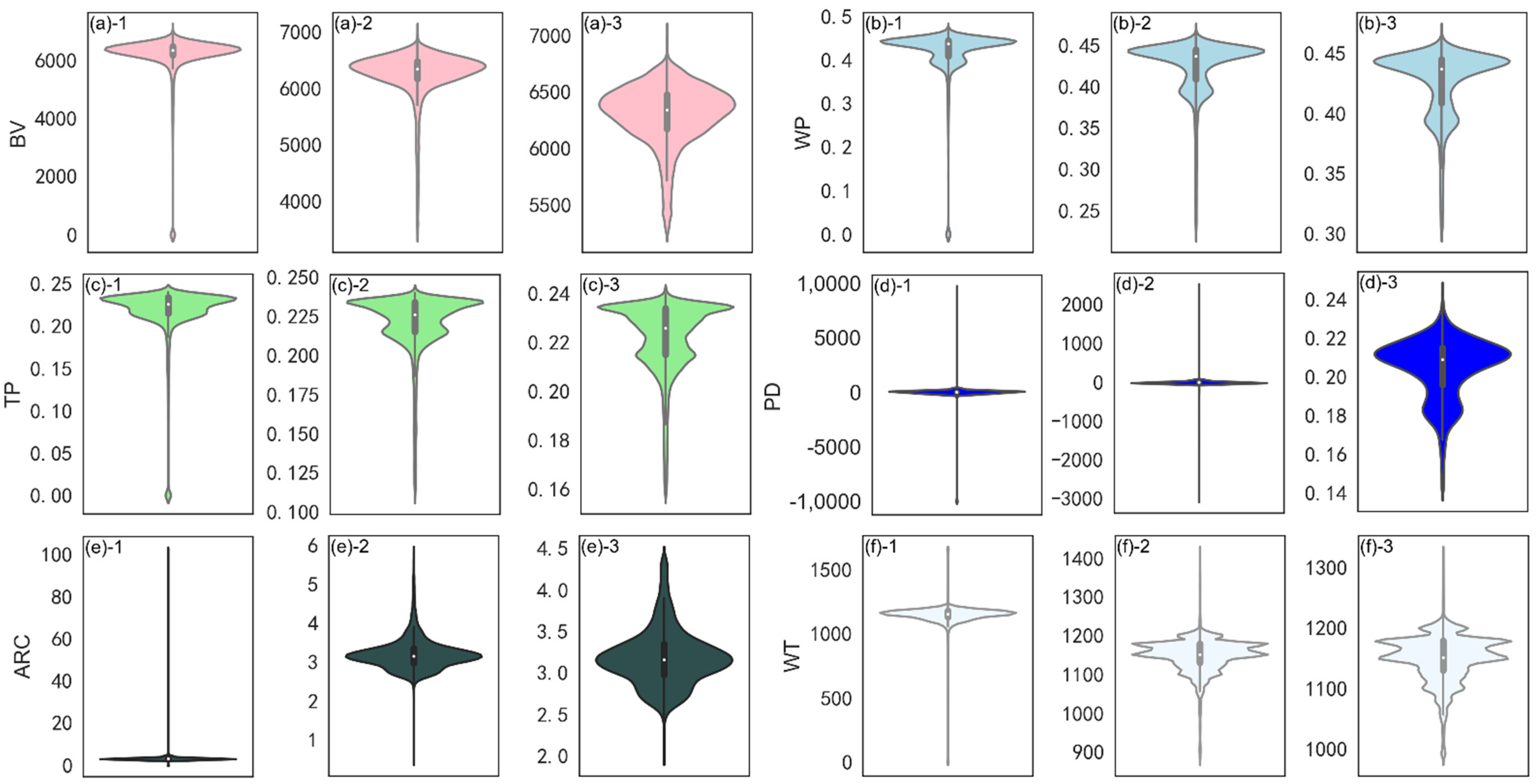
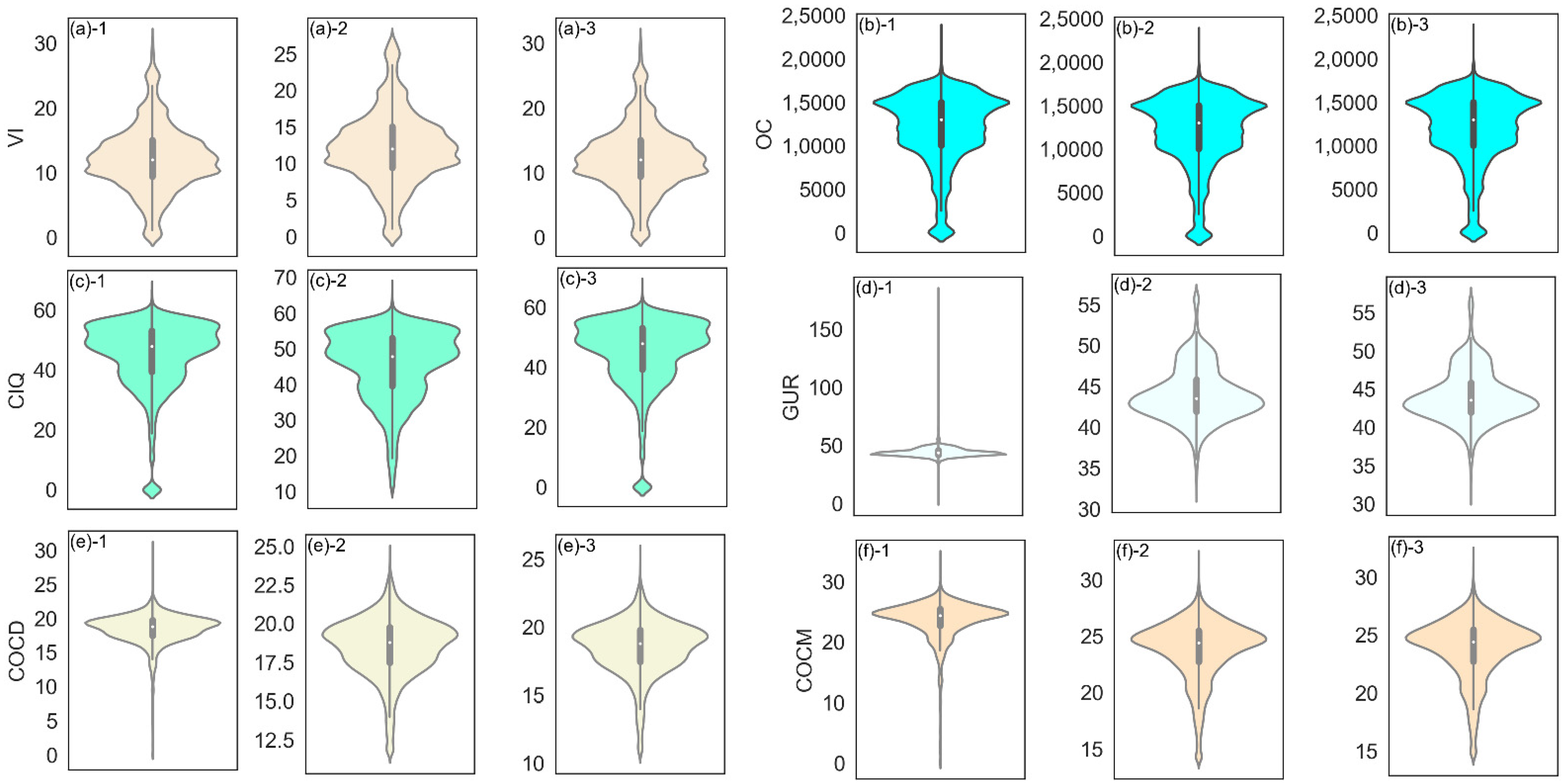
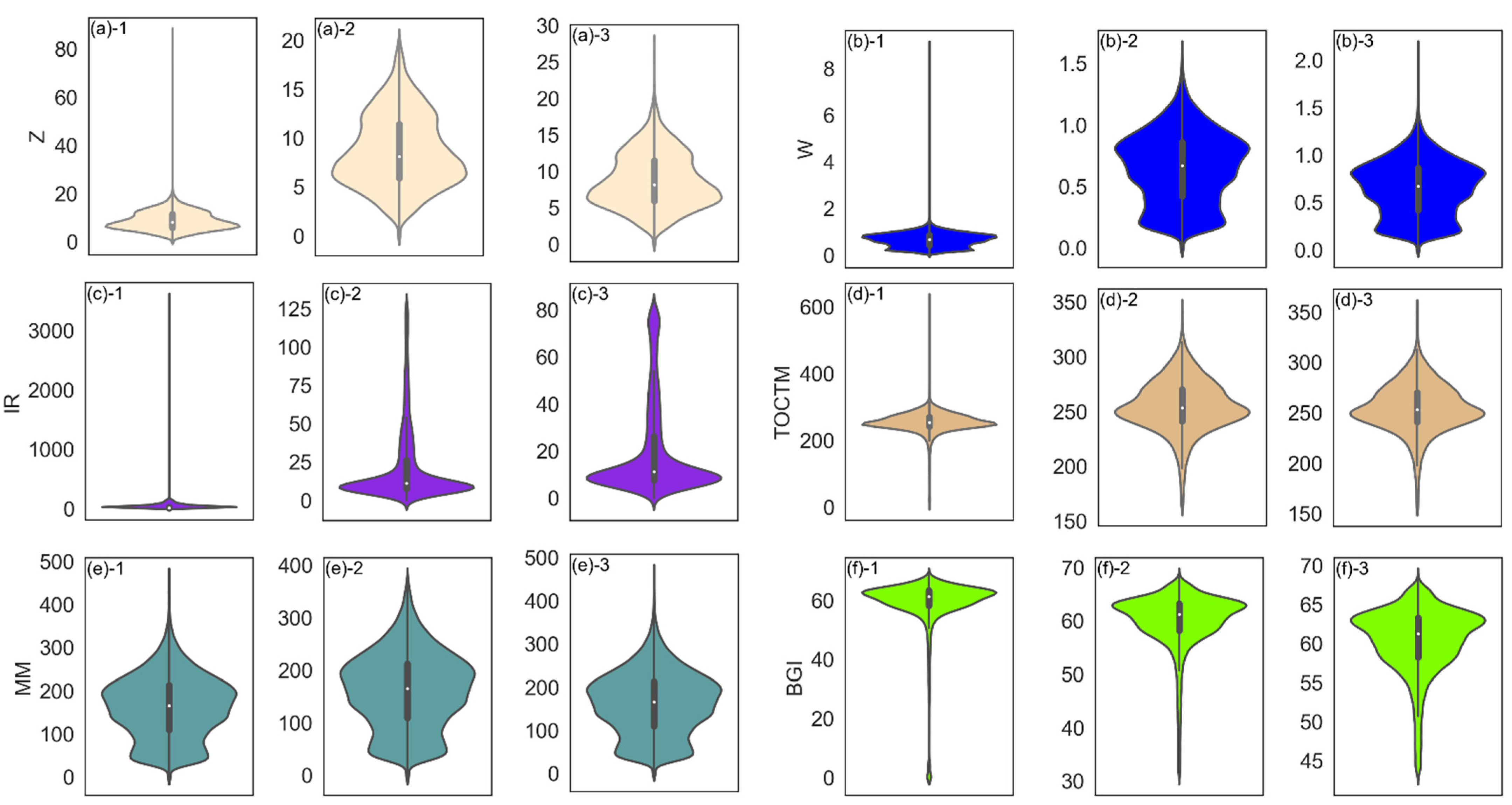
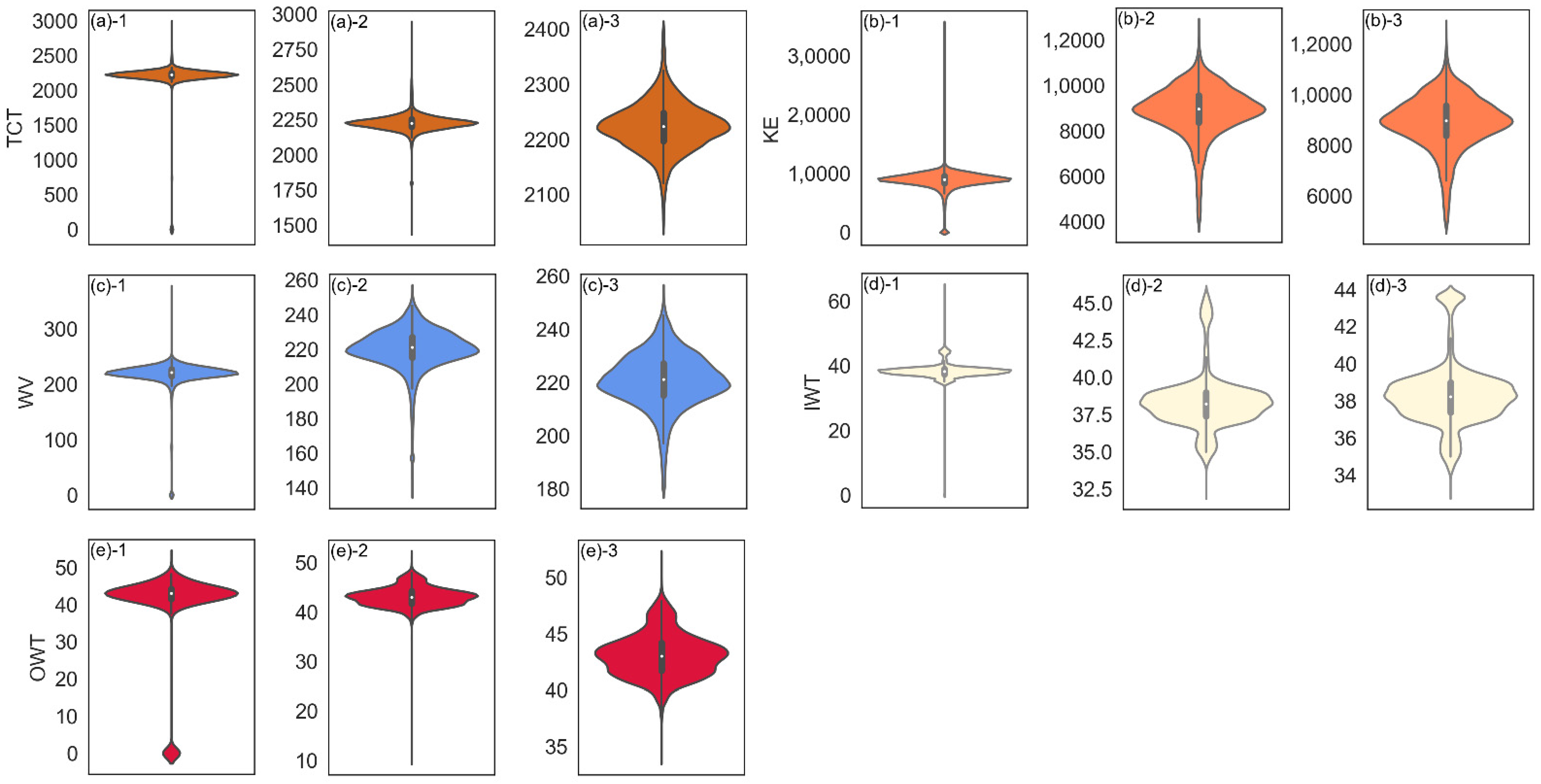
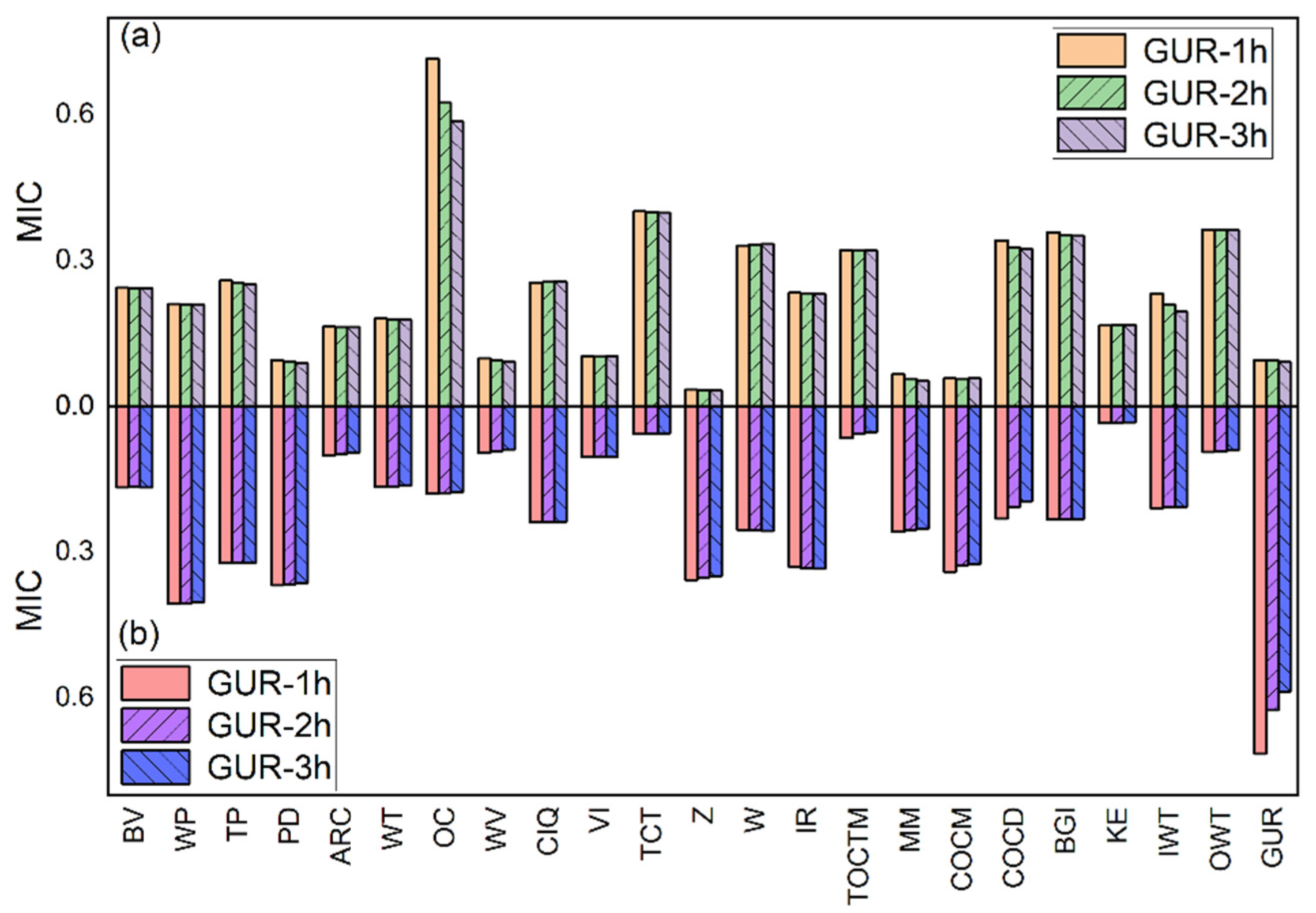

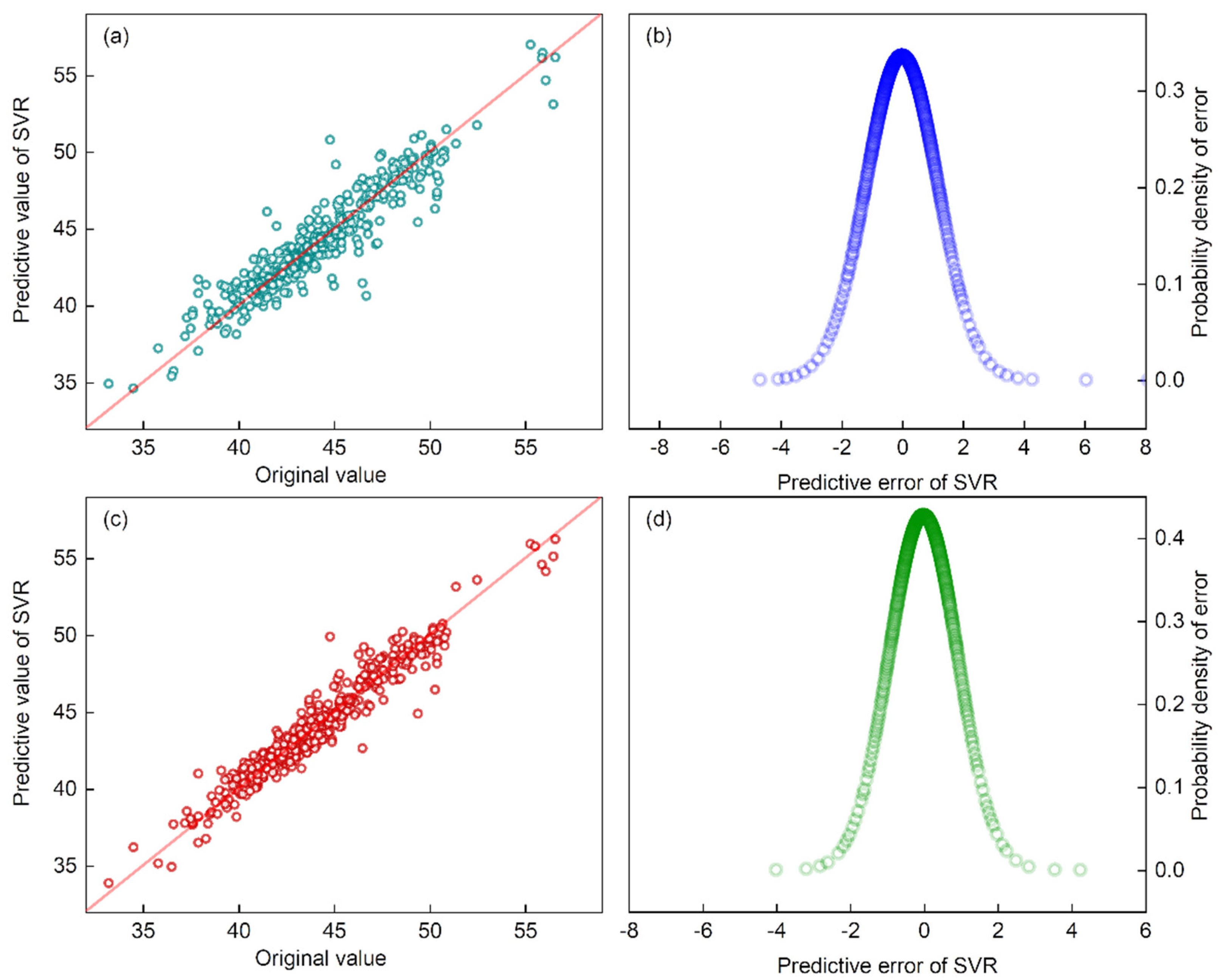

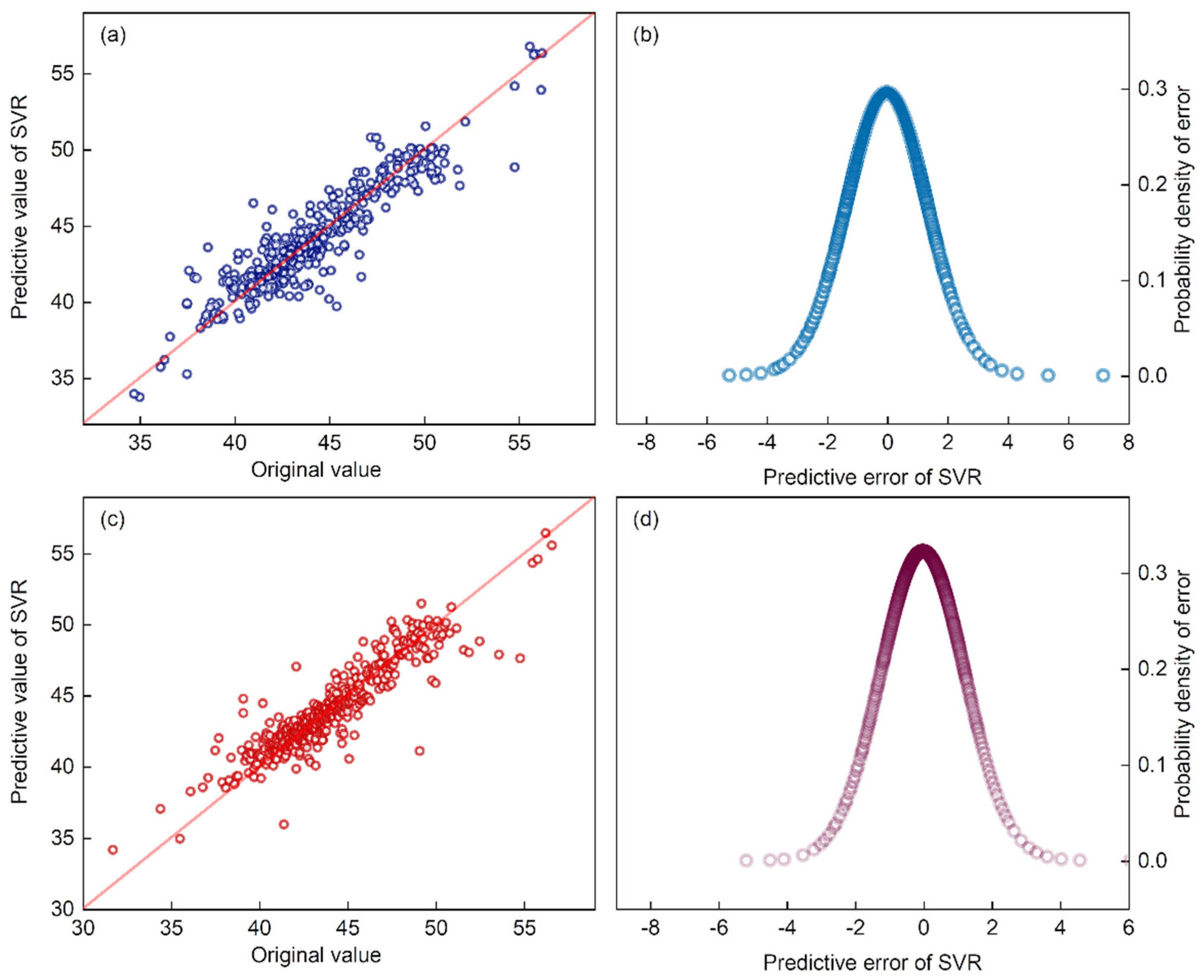

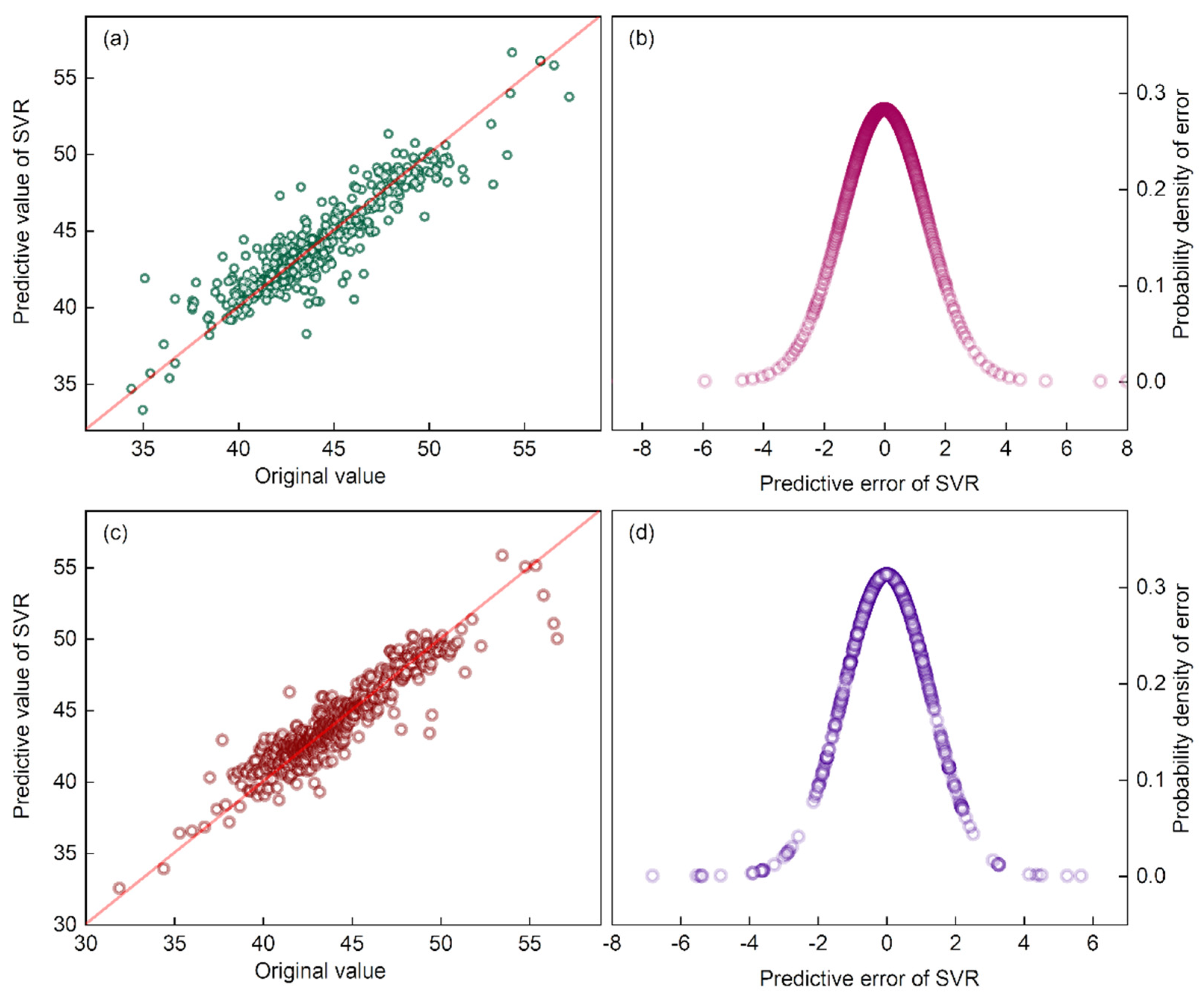
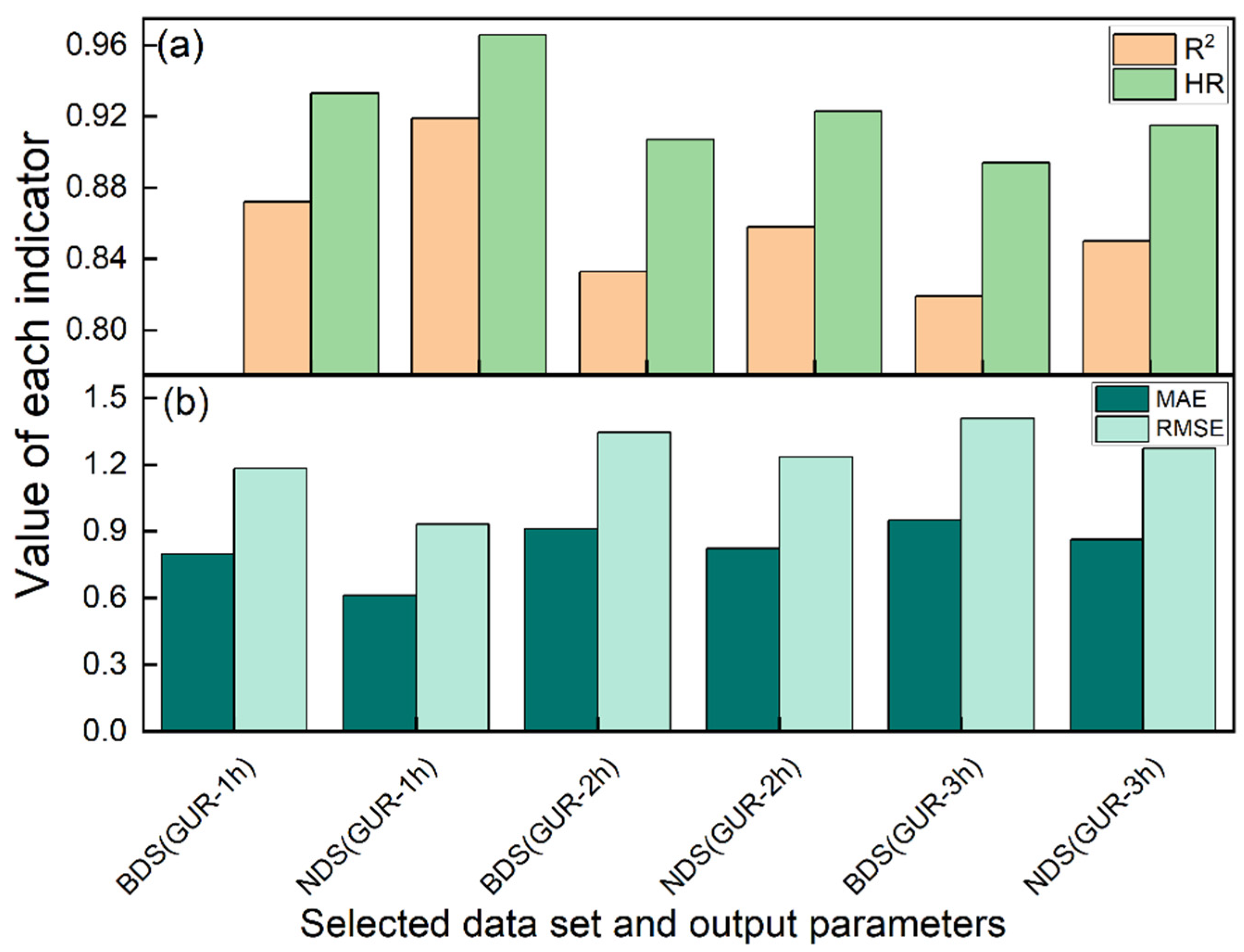
| Actual Physical Meaning | Parameter Name | Unit |
|---|---|---|
| Gas utilization rate | GUR | % |
| Blast volume | BV | Nm3/min |
| Wind pressure | WP | kpa |
| Top pressure | TP | kpa |
| Pressure differential | PD | kpa |
| Air permeability resistance coefficient | ARC | - |
| Wind temperature | WT | °C |
| Ventilating index | VI | m3/min·kpa |
| Oxygen content | OC | Nm3/h |
| Coal injection quantity | CIQ | t |
| Content of carbon dioxide | COCD | % |
| Content of carbon monoxide | COCM | % |
| Center strength | Z | - |
| Edge strength | W | - |
| Intensity ratio (z/w) | IR | - |
| Temperature of cross-temperature measuring | TOCTM | °C |
| Marginal mean | MM | - |
| Bosh gas index | BGI | - |
| Theoretical combustion temperature | TCT | °C |
| (Blast) Kinetic energy | KE | J/s |
| Wind velocity | WV | m/s |
| Inlet water temperature | IWT | °C |
| Outlet water temperature | OWT | °C |
| Common Parameters | Specific Parameters of BDS | Specific Parameters of NDS | |
|---|---|---|---|
| BV | IWT | TOCTM | Z |
| TP | CIQ | ARC | GUR |
| WP | W | TCT | MM |
| WT | COCD | KE | COCM |
| OC | IR | OWT | PD |
| BGI | |||
| Model | SVR Model | ||||
|---|---|---|---|---|---|
| Model parameters | Kernel function | C | γ | ||
| Output parameters | GUR-1h | BDS | RBF | 10 | 0.1 |
| NDS | RBF | 10 | 0.01 | ||
| GUR-2h | BDS | RBF | 10 | 0.1 | |
| NDS | RBF | 100 | 0.01 | ||
| GUR-3h | BDS | RBF | 10 | 0.1 | |
| NDS | RBF | 10 | 0.1 | ||
Publisher’s Note: MDPI stays neutral with regard to jurisdictional claims in published maps and institutional affiliations. |
© 2022 by the authors. Licensee MDPI, Basel, Switzerland. This article is an open access article distributed under the terms and conditions of the Creative Commons Attribution (CC BY) license (https://creativecommons.org/licenses/by/4.0/).
Share and Cite
Jiang, D.; Wang, Z.; Li, K.; Zhang, J.; Ju, L.; Hao, L. Predictive Modeling of Blast Furnace Gas Utilization Rate Using Different Data Pre-Processing Methods. Metals 2022, 12, 535. https://doi.org/10.3390/met12040535
Jiang D, Wang Z, Li K, Zhang J, Ju L, Hao L. Predictive Modeling of Blast Furnace Gas Utilization Rate Using Different Data Pre-Processing Methods. Metals. 2022; 12(4):535. https://doi.org/10.3390/met12040535
Chicago/Turabian StyleJiang, Dewen, Zhenyang Wang, Kejiang Li, Jianliang Zhang, Le Ju, and Liangyuan Hao. 2022. "Predictive Modeling of Blast Furnace Gas Utilization Rate Using Different Data Pre-Processing Methods" Metals 12, no. 4: 535. https://doi.org/10.3390/met12040535
APA StyleJiang, D., Wang, Z., Li, K., Zhang, J., Ju, L., & Hao, L. (2022). Predictive Modeling of Blast Furnace Gas Utilization Rate Using Different Data Pre-Processing Methods. Metals, 12(4), 535. https://doi.org/10.3390/met12040535








